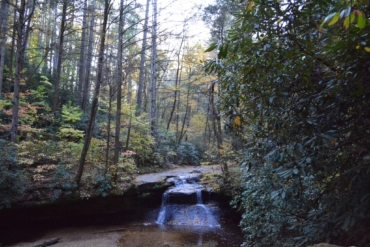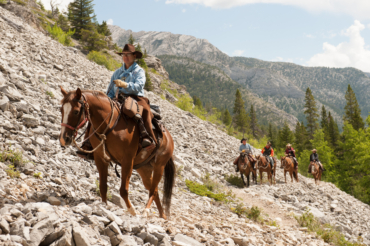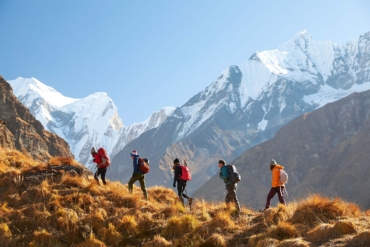It’s a distraction mechanism. My knees are clacking, my mouth has gone dry, and it’s all I can do to muffle the screams inside my head. But here I am, buckled into a harness and clipped by a carabiner into a cable that stretches across the rocky face of Eagle Cliff in the Shawangunk Mountains of Upstate New York.
Someone in front of me needs extra time to navigate a particularly hairy stretch of the route, and I have no choice but to dally. I’m cramming both feet onto a single metal rung the size of a taco, but if I fall, presumably, the harness will catch me, and I’ll suffer only minor abrasions.
It’s all part of my trip to Mohonk Mountain House, a historic old resort near New Paltz, 90 miles north of New York City. I’ve come to experience the first via ferrata in the Shawangunk Mountains. The climbers who flock here to scale its layered, conglomerate rock call it the “Gunks.” It is one of the premier rock-climbing destinations on the East Coast.

Via Ferrata: What Is It?
Via ferrata — Italian for “iron pathway” — traces its roots to World War I. Military units set up wooden ladders and ropes so soldiers could traverse jagged peaks in the Dolomites. The routes mostly fell into disrepair after the war, but 3 decades later, mountaineers resurrected some of them. The climbers replaced rotting wood and worn ropes with metal rungs and steel cables.
Via ferratas have gradually grown in popularity since then. Today, hikers can access about 600 via ferratas in the Dolomites alone. The concept migrated to the United States starting in the 1990s. But because the Wilderness Act of 1964 banned the installation of permanent climbing anchors on federal land, they can’t be built just anywhere.
Most of the U.S. via ferratas are on private land or at resorts. Today, you can buckle into a harness and clip into a via ferrata at Nelson Rocks, W.V., Telluride, Colo., or dozens of points in between.
The new Eagle Cliff Via Ferrata, where I’m currently dangling, crosses a half-mile stretch of rocky cliffs on 1,200 acres of forest owned by Mohonk Mountain House.

Think of these cabled routes as the gateway drug to more difficult climbing. You don’t need any technical climbing experience to do one. And just about any reasonably fit person can access places they’d never otherwise get to see.
The ‘Iron Pathway’ in Upstate New York
From the meeting point near the main lodge, our guided group walked for about 10 minutes to a low cliff wall. Here, we practiced clipping in and using rungs and tiny footholds dubbed “gas pedals” to scuttle across the rock. We then walked another 10 minutes to the start of the actual via ferrata, which is hardly visible to passersby.
The route, which builds in difficulty as you go, took about 3 hours to traverse. (If you really freak out, you can bail at a couple of spots.) Early on, we waddled, one at a time, across an aerial bridge made of cables suspended between high rocky pinnacles. When we reached an overhang, I had to summon all my arm strength to inch across like a bat on a cave wall.

But the rewards were huge. As we crept across a ledge barely wide enough to hold a lizard, I got spectacular views of Mohonk Lake far below and mountains in the distance. I panted aloud as I bearhugged a wall while blindly rounding a bend. But my confidence built as we progressed. As we neared the end, I started to feel calm and comfortable in my new incarnation as a human gecko.
Alex Sherwood, Mohonk’s so-called “endurance concierge,” says he consulted with the local climbing community before installing the via ferrata. Some skilled climbers consider such cabled routes “cheating,” but others say they’re a good way to get non-climbers interested in the sport.
Plus, a via ferrata would fit the aesthetic of Mohonk, where families have come for generations. The lodge dates to 1869, when Albert Smiley founded it as a nature retreat. The resort was already known for its rock “scrambles.”
These marked trails require hikers to clamber over boulders, squeeze through narrow passages and scale steep ladders. There are no TVs in the rooms. But there are hidden reading nooks around every corner and a row of rocking chairs along the back porch.

Why a Via Ferrata at the Gunks?
“A zipline doesn’t fit Mohonk Mountain House and a mountain coaster? Never,” Sherwood said.
A via ferrata, though, could be nestled out of sight behind trees and around rocky crags. It would offer guests a new way to experience the region’s famous climbing cliffs. The Eagle Cliff Via Ferrata opened in May.
When I unclip for the last time at the end of the route, I high-fived my friends and realized that Sherwood had accomplished at least one goal. He got at least one non-climber onto a cliff face high above the ground and made her want to do it again.
Mohonk Mountain House overnight guests can book the tours for $250 per person; participants must be 13 years or older.







